A Wind Tunnel Study on the Correlation between Urban Space Quantification and Pedestrian–Level Ventilation
Abstract
:1. Introduction
2. Methods
2.1. Description of the Research Area and the Wind Tunnel Experiment
2.2. Spatial Partition and Quantification
2.3. The Arrangement of Measurement Points
- Selected index for comparison (O): The openness is quite different for each pair of subspaces, but the area and shape are similar.
- Selected index for comparison (A): The area is quite different for each pair of subspaces, but the shape and openness are similar.
- Selected index for comparison (S): The shape is quite different for each pair of subspaces, but the openness and area are similar.
3. Results and Discussion
3.1. Mean Wind Velocity Ratio of the Subspaces in Different Wind Directions
3.2. Correlation between Wind Velocity Ratio and Urban Space Quantification
4. Conclusions
Supplementary Materials
Author Contributions
Funding
Acknowledgments
Conflicts of Interest
Abbreviations
| PLW | Pedestrian-level wind |
| O | openness |
| A | area (m2) |
| S | shape |
| △O | difference value of openness of each pair of spaces (-) |
| △A | difference value of area of each pair of spaces (m2) |
| △S | difference value of shape of each pair of spaces (-) |
| blocking rate | |
| maximum vertical cross-sectional area of the study object | |
| area of the internal section of the wind tunnel | |
| maximum vertical cross-sectional area of the experiment model | |
| Z | measurement height of wind velocity profile |
| measuring wind velocity at height Z | |
| reference height of the wind velocity profile. In this study, it is 0.3 m | |
| wind velocity at height . In this study, it is 3.8m/s | |
| turbulence intensity at height Z | |
| pedestrian level wind velocity at the measurement points | |
| inflow pedestrian level wind velocity at the measurement points | |
| wind velocity ratio | |
| mean wind velocity ratio | |
| D-value | the differences between of the other three wind directions and that of SSE 157.5° wind direction |
| △ | difference value of the mean wind speed ratio of each pair of spaces |
References
- Oke, T.R. Towards a prescription for the greater use of climatic principles in settlement planning. Energy Build. 1984, 7, 1–10. [Google Scholar] [CrossRef]
- Oke, T.R. Street design and urban canopy layer climate. Energy Build. 1988, 11, 103–113. [Google Scholar] [CrossRef]
- Gabel, J. The Skyscraper Surge Continues in 2015, The ‘Year of 100 Supertalls’. In CTBUH Year in Review: Tall Trends of 2015, and Forecasts for 2016; The Council on Tall Buildings and Urban Habitat: Chicago, IL, USA, 2015. [Google Scholar]
- Krüger, E.L.; Minella, F.O.; Rasia, F. Impact of urban geometry on outdoor thermal comfort and air quality from field measurements in Curitiba, Brazil. Build. Environ. 2011, 46, 621–634. [Google Scholar] [CrossRef]
- Grant, R.H.; Heisler, G.M.; Herrington, L.P. Full-scale comparison of a wind-tunnel simulation of windy locations in an urban area. J. Wind Eng. Ind. Aerodyn. 1988, 31, 335–341. [Google Scholar] [CrossRef]
- Arens, EA. Designing for an acceptable wind environment. Transp. Eng. J. 1981, 107, 127–141. [Google Scholar]
- Adamek, K.; Vasan, N.; Elshaer, A.; English, E.; Bitsuamlak, G. Pedestrian level wind assessment through city development: A study of the financial district in Toronto. Sustain. Cities Soc. 2017, 35, 178–190. [Google Scholar] [CrossRef]
- Hang, J.; Sandberg, M.; Li, Y. Effect of urban morphology on wind condition in idealized city models. Atmos. Environ. 2009, 43, 869–878. [Google Scholar] [CrossRef]
- Ng, E. Policies and technical guidelines for urban planning of high-density cities–air ventilation assessment (AVA) of Hong Kong. Build. Environ. 2009, 44, 1478–1488. [Google Scholar] [CrossRef]
- Blocken, B.; Carmeliet, J. Pedestrian wind environment around buildings: Literature review and practical examples. J. Therm. Envel. Build. Sci. 2004, 28, 107–159. [Google Scholar] [CrossRef]
- Blocken, B.; Stathopoulos, T.; Van Beeck, J. Pedestrian-level wind conditions around buildings: Review of wind-tunnel and CFD techniques and their accuracy for wind comfort assessment. Build. Environ. 2016, 100, 50–81. [Google Scholar] [CrossRef]
- Iqbal, Q.M.Z.; Chan, A.L.S. Pedestrian level wind environment assessment around group of high-rise cross-shaped buildings: Effect of building shape, separation and orientation. Build. Environ. 2016, 101, 45–63. [Google Scholar] [CrossRef]
- Mittal, H.; Sharma, A.; Gairola, A. A review on the study of urban wind at the pedestrian level around buildings. J. Build. Eng. 2018, 18, 154–163. [Google Scholar] [CrossRef]
- Blocken, B.; van Druenen, T.; Toparlar, Y.; Malizia, F.; Mannion, P.; Andrianne, T.; Marchal, T.; Maas, G.-J.; Diepens, J. Aerodynamic drag in cycling pelotons: New insights by CFD simulation and wind tunnel testing. J. Wind Eng. Ind. Aerodyn. 2018, 179, 319–337. [Google Scholar] [CrossRef]
- Wise, A.F.E.; Sexton, D.E.; Lillywhite, M.S.T. Studies of Air Flow Round Buildings (No. Design Ser-38); Building Research Station: Watford, UK, 1965. [Google Scholar]
- Lawson, T.V. The Wind Environment of Buildings: A Logical Approach to the Establishment of Criteria; Report No. TVL.; Department of Aeronautical Engineering, University of Bristol: Bristol, UK, 1973; p. 7321. [Google Scholar]
- Wu, H.; Stathopoulos, T. Wind-tunnel techniques for assessment of pedestrian-level winds. J. Eng. Mech. 1993, 119, 1920–1936. [Google Scholar] [CrossRef]
- Yassin, M.F.; Kato, S.; Ooka, R.; Takahashi, T.; Kouno, R. Field and wind-tunnel study of pollutant dispersion in a built-up area under various meteorological conditions. J. Wind Eng. Ind. Aerodyn. 2005, 93, 361–382. [Google Scholar] [CrossRef]
- Kubota, T.; Miura, M.; Tominaga, Y.; Mochida, A. Wind tunnel tests on the relationship between building density and pedestrian-level wind velocity: Development of guidelines for realizing acceptable wind environment in residential neighborhoods. Build. Environ. 2008, 43, 1699–1708. [Google Scholar] [CrossRef]
- Antoniou, N.; Montazeri, H.; Wigo, H.; Neophytou, M.K.-A.; Blocken, B.; Sandberg, M. CFD and wind-tunnel analysis of outdoor ventilation in a real compact heterogeneous urban area: Evaluation using “air delay”. Build. Environ. 2017, 126, 355–372. [Google Scholar] [CrossRef]
- He, Y.; Tablada, A.; Wong, N.H. A parametric study of angular road patterns on pedestrian ventilation in high-density urban areas. Build. Environ. 2019, 151, 251–267. [Google Scholar] [CrossRef]
- Tominaga, Y.; Yoshie, R.; Mochida, A.; Kataoka, H.; Harimoto, K.; Nozu, T. Cross comparisons of CFD prediction for wind environment at pedestrian level around buildings. Part 2: Comparison of Results for Flowfield around Building Complex in Actual Urban Area. In Proceedings of the Sixth Asia-Pacific Conference on Wind Engeenering (APCWE-VI), Seoul, Korea, 12–14 September 2005; pp. 2661–2670. [Google Scholar]
- Liu, X.P.; Niu, J.L.; Kwok, K.C.; Wang, J.H.; Li, B.Z. Investigation of indoor air pollutant dispersion and cross-contamination around a typical high-rise residential building: Wind tunnel tests. Build. Environ. 2010, 45, 1769–1778. [Google Scholar] [CrossRef]
- Weerasuriya, A.U.; Tse, K.T.; Zhang, X.; Li, S.W. A wind tunnel study of effects of twisted wind flows on the pedestrian-level wind field in an urban environment. Build. Environ. 2018, 128, 225–235. [Google Scholar] [CrossRef]
- An, K.; Fung, J.C.H.; Yim, S.H.L. Sensitivity of inflow boundary conditions on downstream wind and turbulence profiles through building obstacles using a CFD approach. J. Wind Eng. Ind. Aerodyn. 2013, 115, 137–149. [Google Scholar] [CrossRef]
- Toparlar, Y.; Blocken, B.; Maiheu, B.; Van Heijst, G. A review on the CFD analysis of urban microclimate. Renew. Sustain. Energy Rev. 2017, 80, 1613–1640. [Google Scholar] [CrossRef]
- Peng, Y.; Gao, Z.; Buccolieri, R.; Ding, W. An investigation of the quantitative correlation between urban morphology parameters and outdoor ventilation efficiency indices. Atmosphere 2019, 10, 33. [Google Scholar] [CrossRef]
- You, W.; Shen, J.; Ding, W. Improving residential building arrangement design by assessing outdoor ventilation efficiency in different regional spaces. Archit. Sci. Rev. 2018, 61, 202–214. [Google Scholar] [CrossRef]
- Gao, Y.; Yao, R.; Li, B.; Turkbeyler, E.; Luo, Q.; Short, A. Field studies on the effect of built forms on urban wind environments. Renew. Energy 2012, 46, 148–154. [Google Scholar] [CrossRef]
- Gu, Y.; Ding, W. Reseach on the Setting of the Range of Test Area in CFD Simulation of City Slices. Master’s Thesis, Nanjing University, Nanjing, China, 2018. (In Chinese). [Google Scholar]
- Tominaga, Y.; Yoshie, R.; Mochida, A.; Kataoka, H.; Harimoto, K.; Nozu, T. Cross comparisons of CFD prediction for wind environment at pedestrian level around buildings. Part 1: Comparison of Results for Flow-field around a High-rise Building Located in Surrounding City Blocks. In Proceedings of the Sixth Asia-Pacific Conference on Wind Engeenering (APCWE-VI), Seoul, Korea, 12–14 September 2005; pp. 2648–2659. [Google Scholar]
- China Meteorological Information Center Meteorological. Chinese Building Thermal Environment Analysis of Specialized Meteorological Data Collection; China Architecture & Building Press: Beijing, China, 2005. (In Chinese) [Google Scholar]
- Mattuella, J.M.L.; Loredo-Souza, A.M.; Oliveira, M.G.K.; Petry, A.P. Wind tunnel experimental analysis of a complex terrain micrositing. Renew. Sustain. Energy Rev. 2016, 54, 110–119. [Google Scholar] [CrossRef]
- Irwin, H.P.A.H. A simple omnidirectional sensor for wind-tunnel studies of pedestrian-level winds. J. Wind Eng. Ind. Aerodyn. 1981, 7, 219–239. [Google Scholar] [CrossRef]
- Li, Y. Study on Wind Tunnel Experiment and Its Application in the Field of Architectural Construction. Build. Sci. 2011, 27, 117–122. [Google Scholar]
- Standard for Wind Tunnel Test of Buildings and Structures (JGJ/T 338-2014); China Architecture & Building Press: Beijing, China, 2014. (In Chinese)
- Load Code for the Design of Building Structures (GB 50009-2012). China Architecture & Building Press: Beijing, China, 2012; pp. 31–32. (In Chinese)
- Ji, H.; Peng, Y.; Ding, W. A Quantitative Study of Geometric Characteristics of Urban Space Based on the Correlation with Microclimate. Sustainability 2019, 11, 4951. [Google Scholar] [CrossRef]
- Ji, H.; Ding, W.; Tang, L. A Classification Method and System of Urban Street Spatial Form. China Patent 201910379538.0, 8 May 2019. (In Chinese). [Google Scholar]
- Bu, Z.; Kato, S.; Ishida, Y.; Huang, H. New criteria for assessing local wind environment at pedestrian level based on exceedance probability analysis. Build. Environ. 2009, 44, 1501–1508. [Google Scholar] [CrossRef]
- Bady, M.; Kato, S.; Ishida, Y.; Huang, H.; Takahashi, T. Application of exceedance probability based on wind kinetic energy to evaluate the pedestrian level wind in dense urban areas. Build. Environ. 2011, 46, 1834–1842. [Google Scholar] [CrossRef]
- Willemsen, E.; Wisse, J.A. Design for wind comfort in The Netherlands: Procedures, criteria and open research issues. J. Wind Eng. Ind. Aerodyn. 2007, 95, 1541–1550. [Google Scholar] [CrossRef]
- Hu, T.; Yoshie, R. Indices to evaluate ventilation efficiency in newly-built urban area at pedestrian level. J. Wind Eng. Ind. Aerodyn. 2013, 112, 39–51. [Google Scholar] [CrossRef]

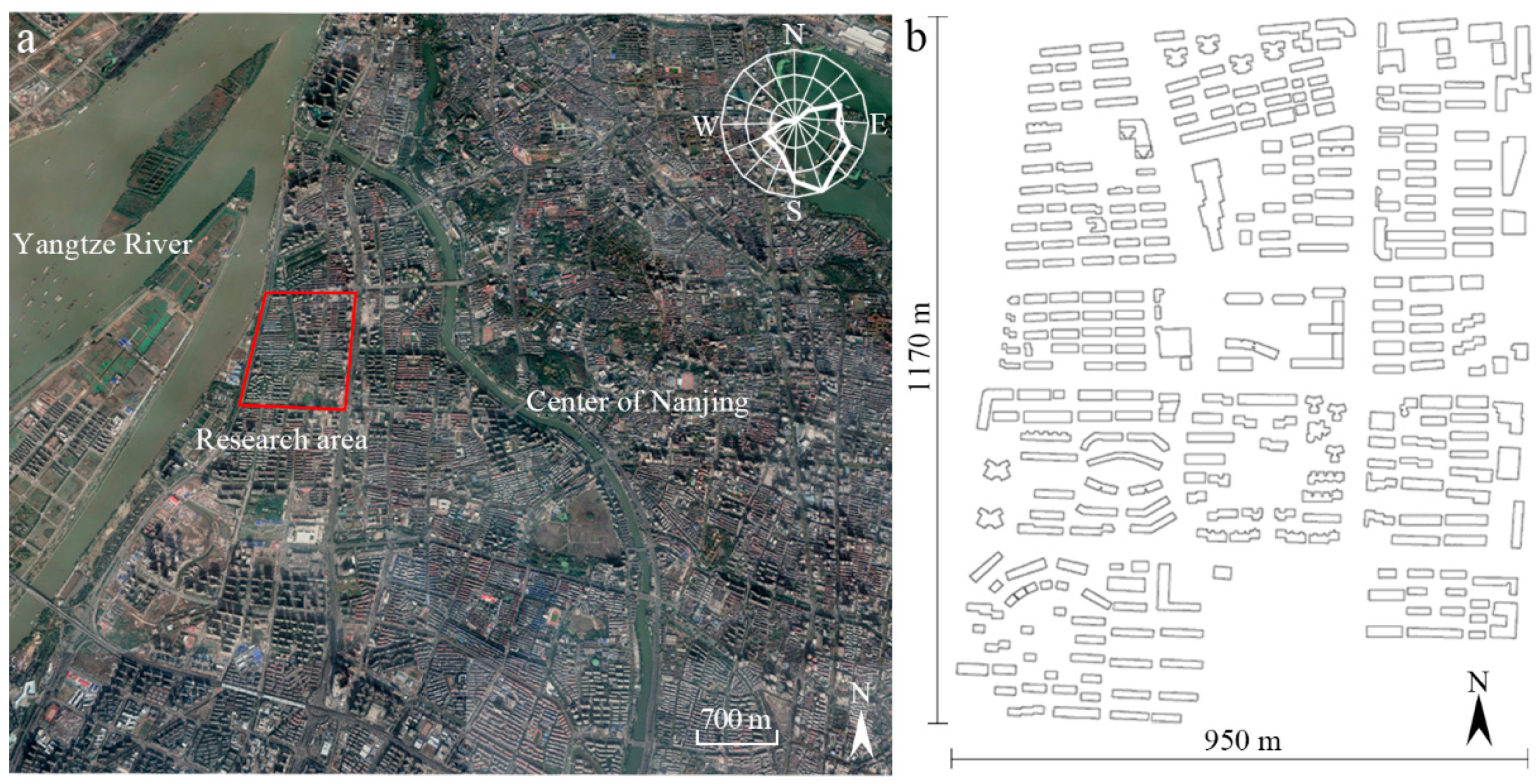


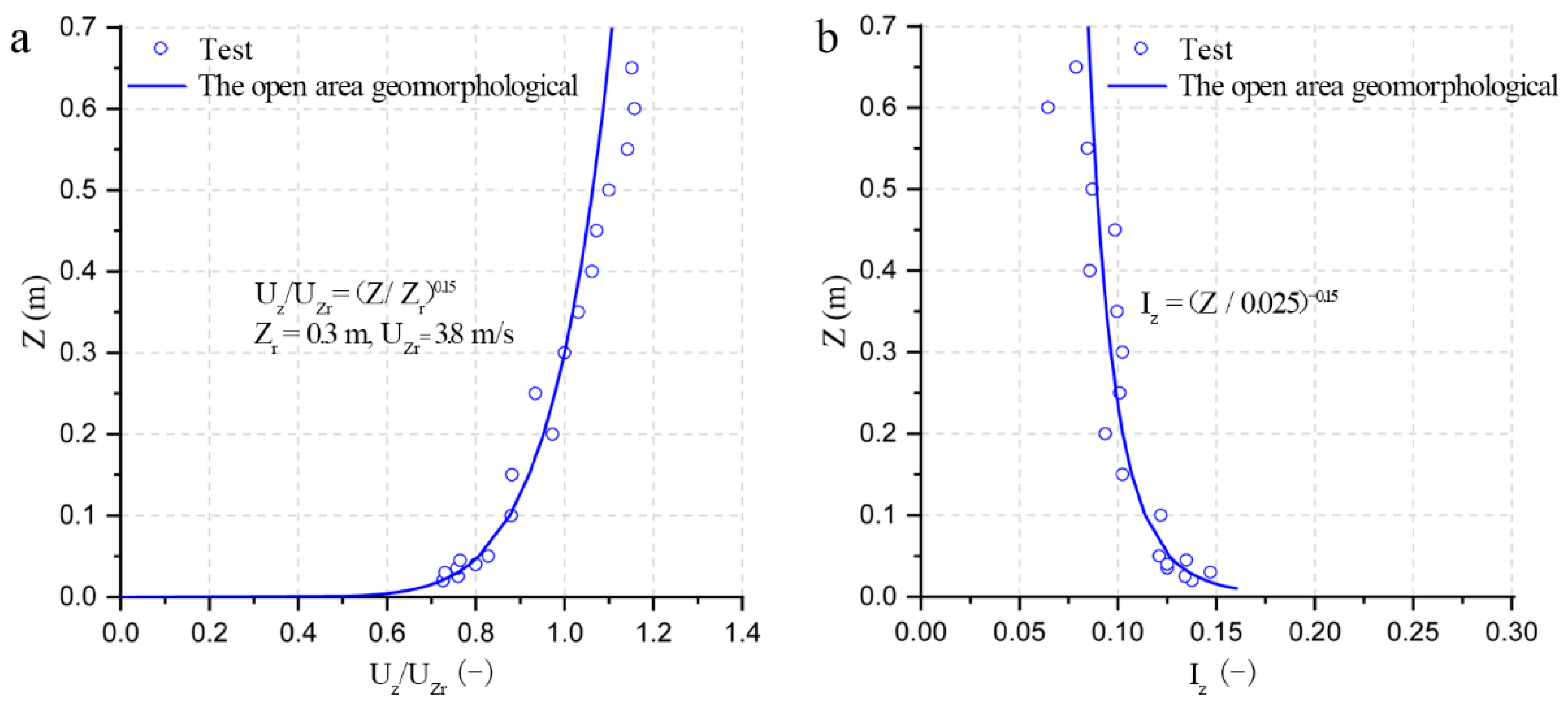
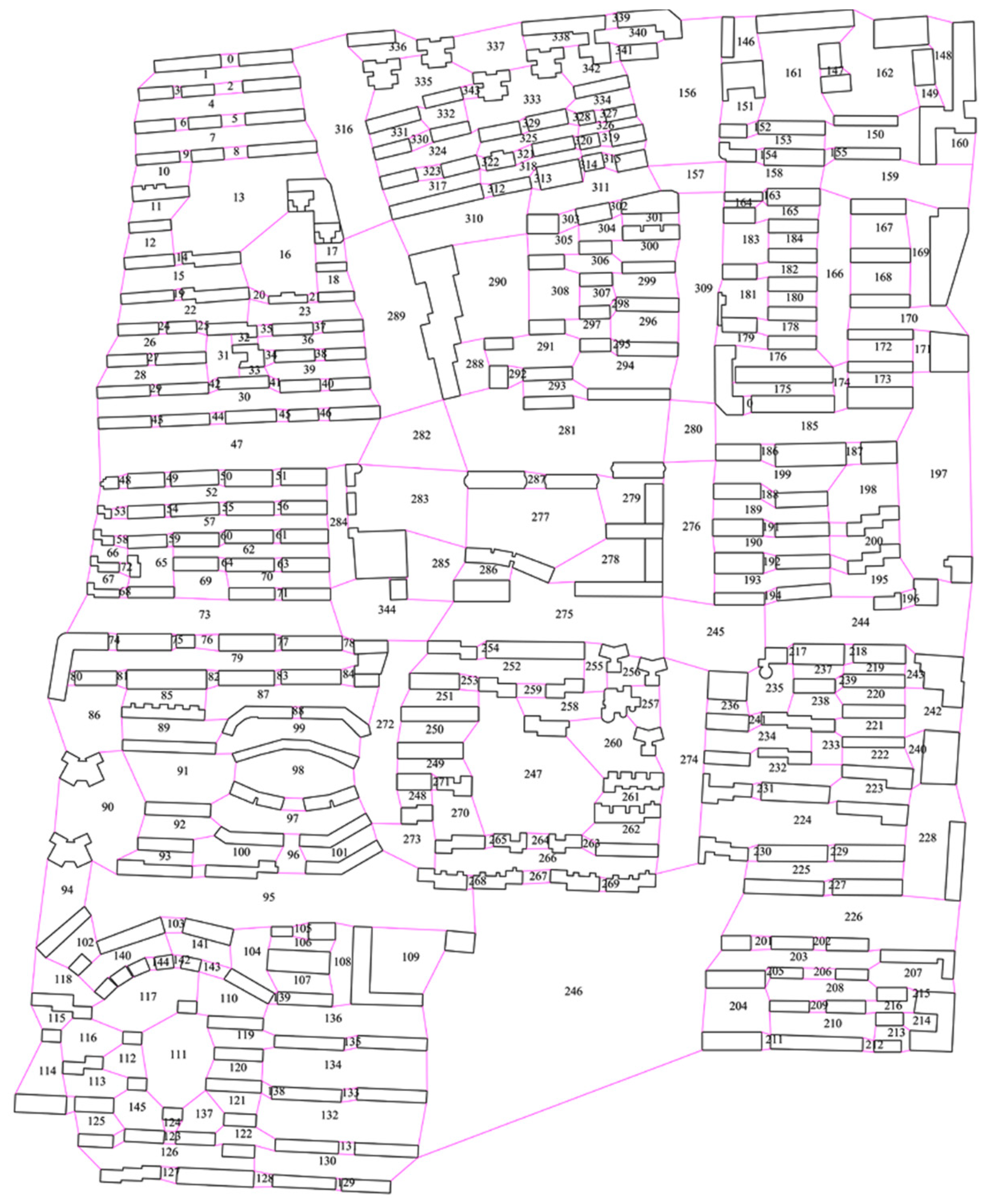
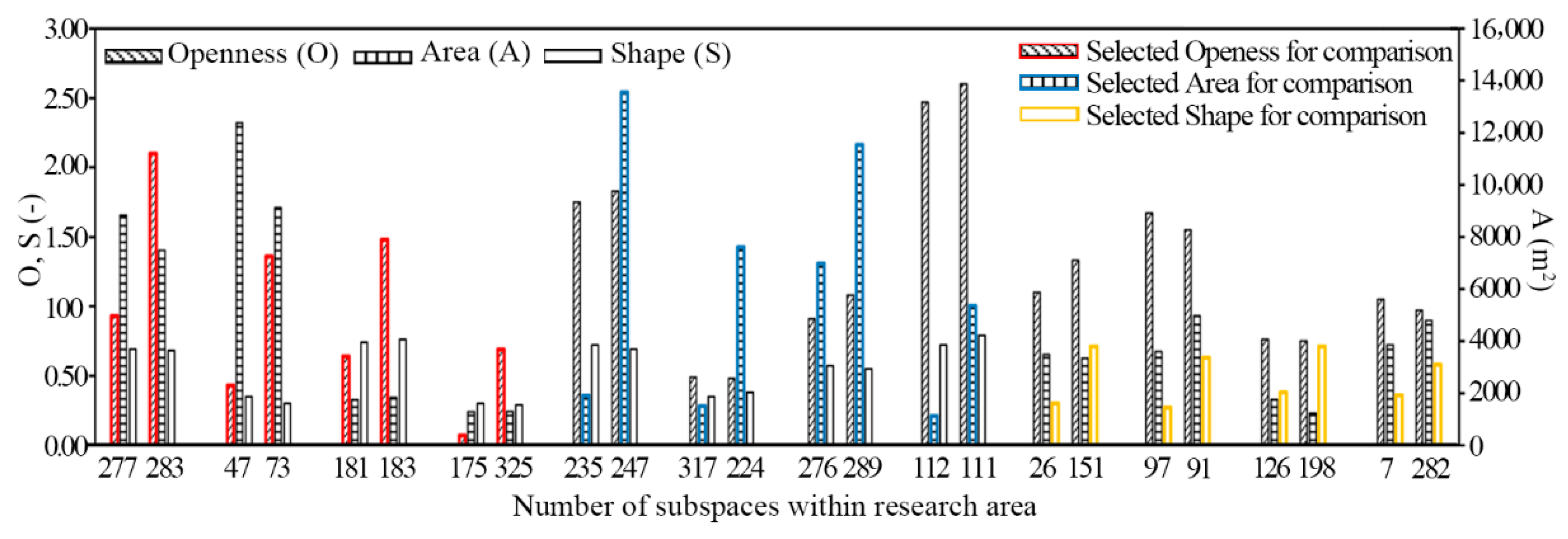

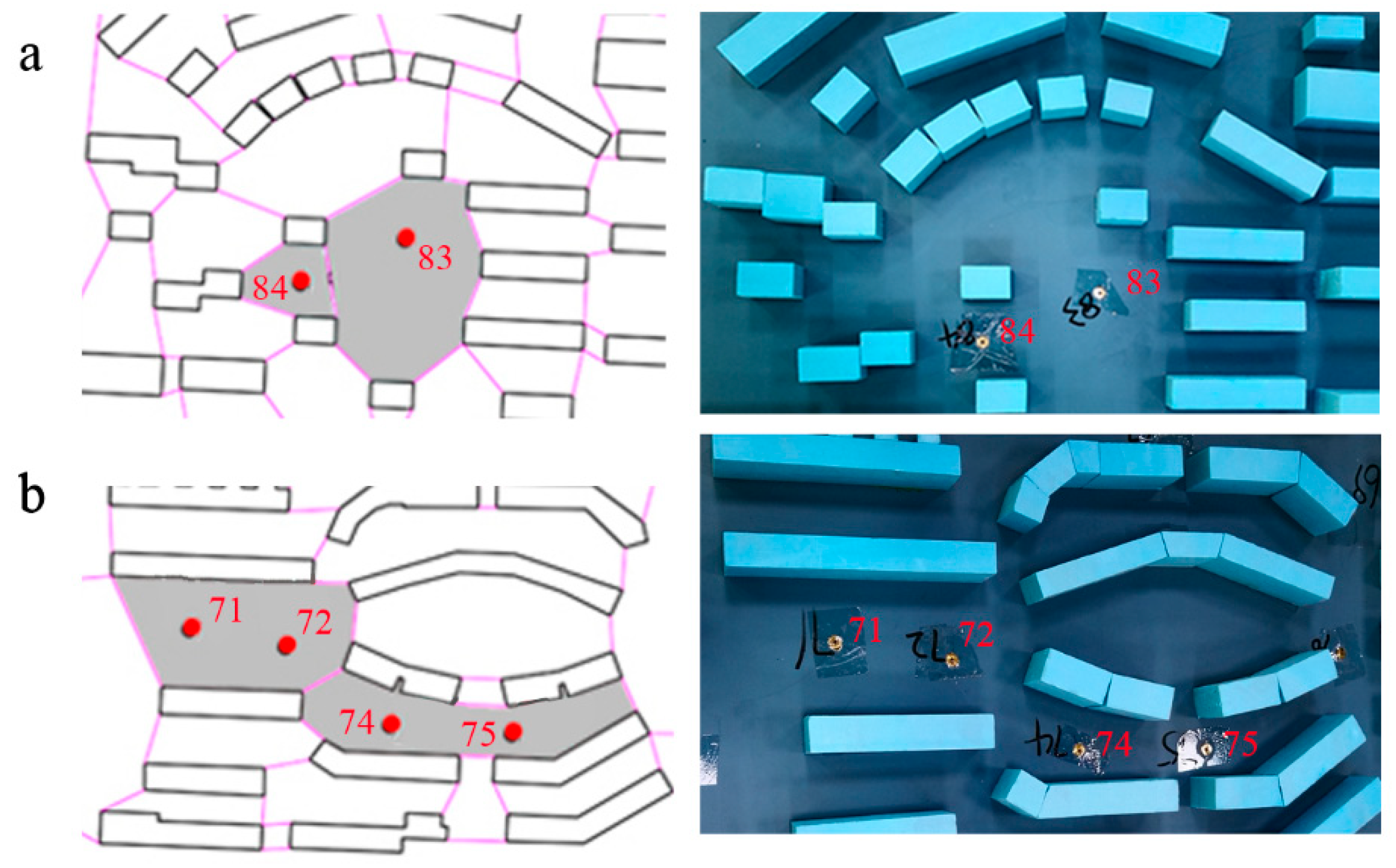

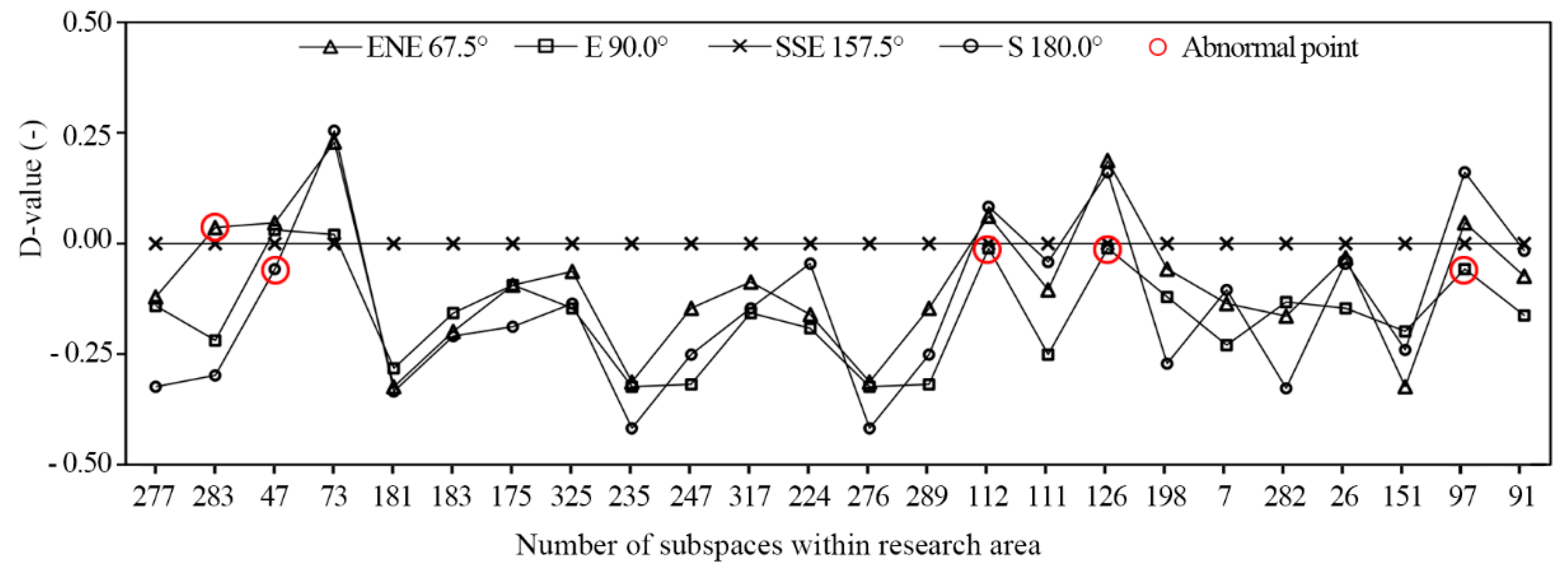
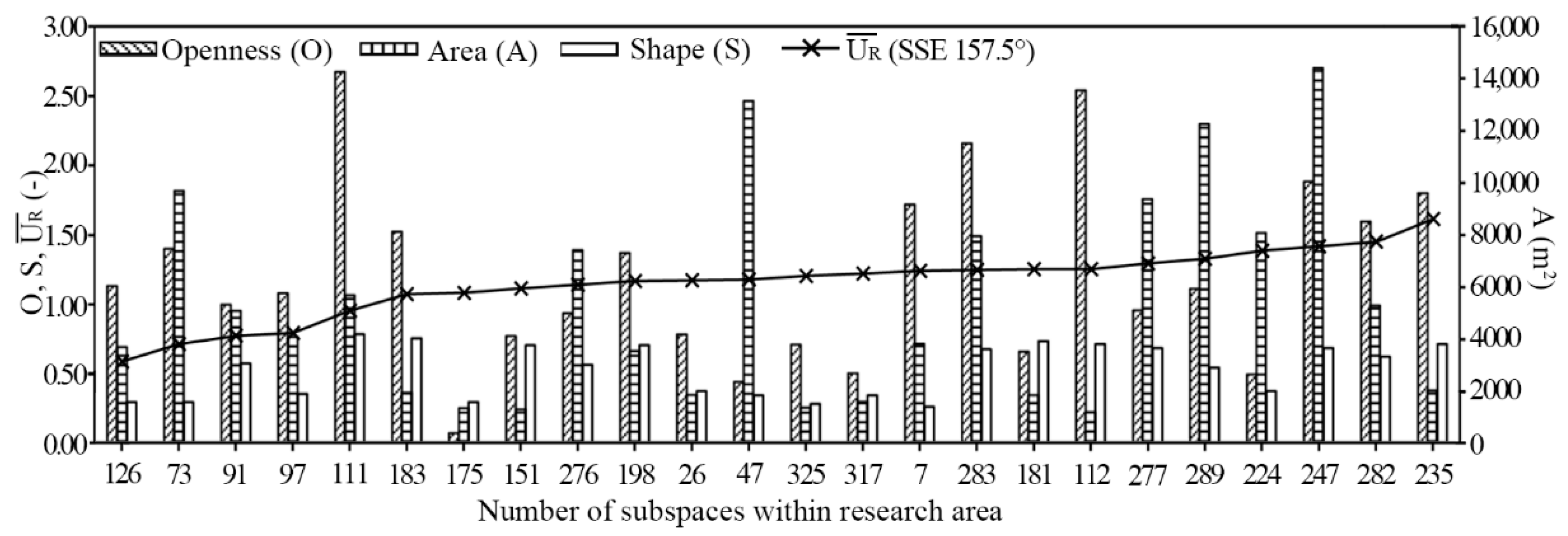

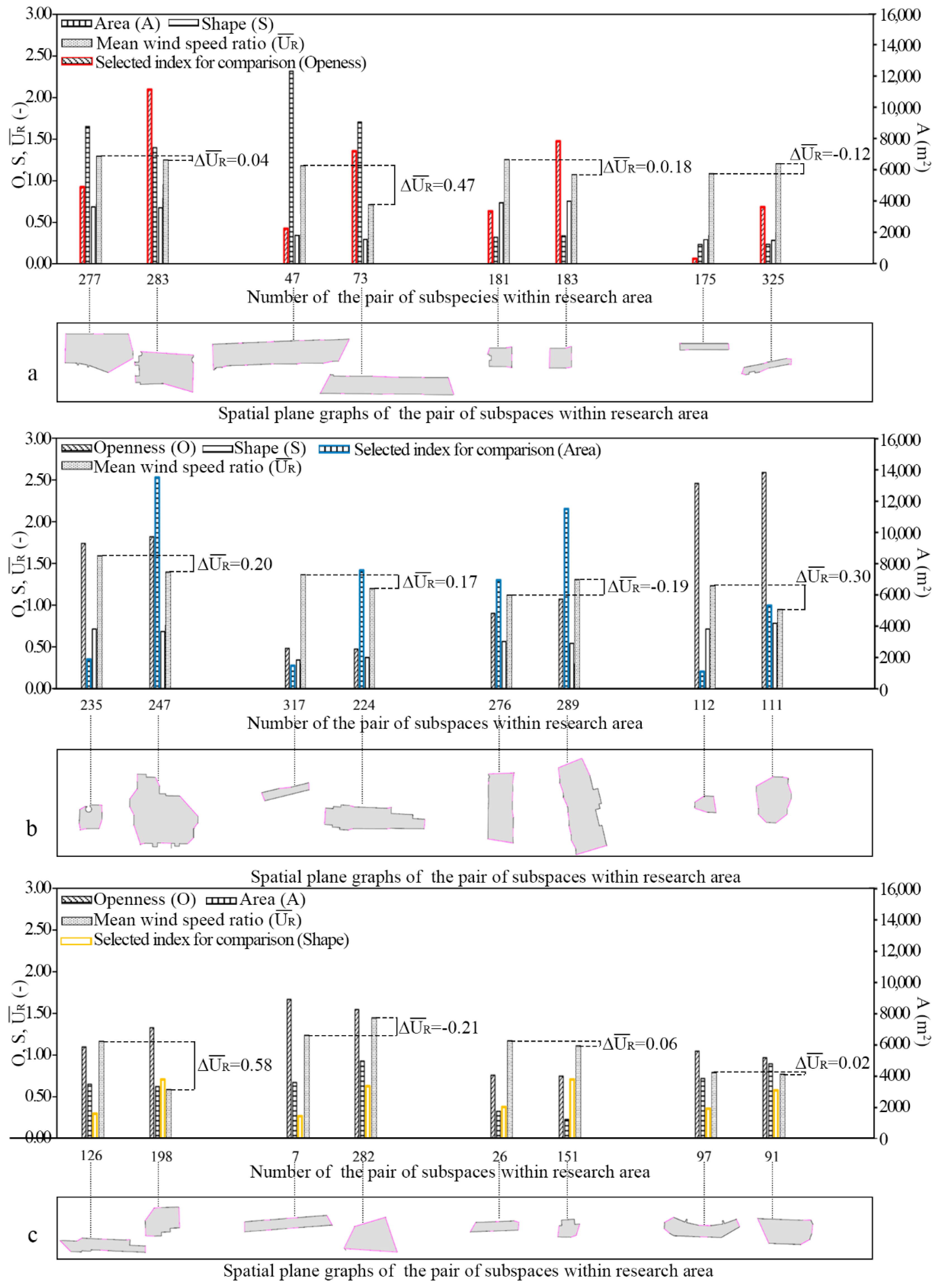
| Experimental Condition | Case 1 | Case 2 | Case 3 | Case 4 | Case 5 | Case 6 | Case 7 | Case 8 |
|---|---|---|---|---|---|---|---|---|
| Wind velocity (m/s) | 2.1 | 2.1 | 2.1 | 2.1 | 2.8 | 2.8 | 2.8 | 2.8 |
| Wind direction | S 180.0° | SSE 157.5° | E 90.0° | ENE 67.5° | S 180.0° | SSE 157.5° | E 90.0° | ENE 67.5° |
| Subspace Number | Openness (O)/- | Area (A)/m2 | Shape (S)/- |
|---|---|---|---|
| 0 | 0.94 | 224 | 0.76 |
| 1 | 1.19 | 2242 | 0.24 |
| 2 | 0.89 | 314 | 0.61 |
| 3 | 0.63 | 88 | 0.72 |
| … | … | … | … |
| 351 | 1.43 | 265 | 0.65 |
| Selected Index for Comparison (Openness) | Selected Index for Comparison (Area) | Selected Index for Comparison (Shape) | ||||||||||||
|---|---|---|---|---|---|---|---|---|---|---|---|---|---|---|
| Subspace Number | O | A | S | △O | Subspace Number | O | A | S | △A | Subspace Number | O | A | S | △S |
| (-) | (m2) | (-) | (-) | (-) | (m2) | (-) | (m2) | (-) | (m2) | (-) | (-) | |||
| 277 | 0.93 | 8810 | 0.69 | 1.17 | 235 | 1.75 | 1911 | 0.72 | 11,594 | 277 | 126 | 1.10 | 3481 | 0.41 |
| 283 | 2.10 | 7467 | 0.68 | 247 | 1.83 | 13,505 | 0.69 | 283 | 198 | 1.33 | 3338 | |||
| 47 | 0.43 | 12,330 | 0.35 | 0.93 | 317 | 0.49 | 1516 | 0.35 | 6075 | 47 | 7 | 1.67 | 3598 | 0.36 |
| 73 | 1.36 | 9094 | 0.3 | 224 | 0.48 | 7591 | 0.38 | 73 | 282 | 1.55 | 4972 | |||
| 181 | 0.64 | 1754 | 0.74 | 0.84 | 276 | 0.91 | 6968 | 0.57 | 4534 | 181 | 26 | 0.76 | 1763 | 0.33 |
| 183 | 1.48 | 1836 | 0.76 | 289 | 1.08 | 11,502 | 0.55 | 183 | 151 | 0.75 | 1241 | |||
| 175 | 0.07 | 1290 | 0.3 | 0.62 | 112 | 2.47 | 1136 | 0.72 | 4211 | 175 | 97 | 1.05 | 3846 | 0.22 |
| 325 | 0.69 | 1306 | 0.29 | 111 | 2.60 | 5347 | 0.79 | 325 | 91 | 0.97 | 4791 | |||
| Measurement Points Number | Experimental Conditions | |||||||
|---|---|---|---|---|---|---|---|---|
| Case 1 | Case 2 | Case 3 | Case 4 | Case 5 | Case 6 | Case 7 | Case 8 | |
| 34 | 2.69 | 3.20 | 2.91 | 2.75 | 2.32 | 4.26 | 3.50 | 3.66 |
| 53 | 2.58 | 3.22 | 2.38 | 2.90 | 2.77 | 4.38 | 2.45 | 3.55 |
| 32 | 1.99 | 2.36 | 2.29 | 2.71 | 2.08 | 2.78 | 2.44 | 3.40 |
| … | … | … | … | … | … | … | … | … |
| 59 | 2.26 | 2.42 | 3.13 | 2.87 | 2.04 | 2.80 | 2.51 | 3.49 |
| Subspace Number | Measurement Points Number | ||||||||
|---|---|---|---|---|---|---|---|---|---|
| S | SSE | E | ENE | S | SSE | E | ENE | ||
| 180.0° | 157.5° | 90.0° | 67.5° | 180° | 157.5° | 90.0° | 67.5° | ||
| 277 | 34 | 1.06 | 1.52 | 1.32 | 1.31 | 0.98 | 1.29 | 1.16 | 1.18 |
| 53 | 0.90 | 1.06 | 0.99 | 1.04 | |||||
| 283 | 32 | 0.85 | 1.06 | 0.98 | 1.25 | 0.96 | 1.25 | 1.04 | 1.28 |
| 33 | 1.07 | 1.43 | 1.09 | 1.31 | |||||
| … | … | … | … | … | … | … | … | … | … |
| 91 | 71 | 0.68 | 0.9 | 0.64 | 0.77 | 0.76 | 0.77 | 0.62 | 0.70 |
| 72 | 0.83 | 0.64 | 0.59 | 0.63 | |||||
| Wind Direction | ENE 67.5° | E 90.0° | SSE 157.5° | S 180.0° |
|---|---|---|---|---|
| ENE 67.5° | 1.00 | |||
| E 90.0° | 0.91 | 1.00 | ||
| SSE 157.5° | 0.83 | 0.92 | 1.00 | |
| S 180.0° | 0.85 | 0.81 | 0.75 | 1.00 |
| Subspace Number | Subspace Number | Subspace Number | ||||||
|---|---|---|---|---|---|---|---|---|
| 277 | 1.29 | –0.04 | 235 | 1.61 | –0.19 | 126 | 0.59 | 0.58 |
| 283 | 1.25 | 247 | 1.42 | 198 | 1.17 | |||
| 47 | 1.18 | –0.47 | 317 | 1.22 | 0.16 | 7 | 1.24 | 0.21 |
| 73 | 0.71 | 224 | 1.38 | 282 | 1.45 | |||
| 181 | 1.25 | –0.18 | 276 | 1.14 | 0.18 | 26 | 1.17 | –0.06 |
| 183 | 1.07 | 289 | 1.32 | 151 | 1.11 | |||
| 175 | 1.08 | 0.12 | 112 | 1.25 | –0.30 | 97 | 0.79 | –0.02 |
| 325 | 1.20 | 111 | 0.95 | 91 | 0.77 |
© 2019 by the authors. Licensee MDPI, Basel, Switzerland. This article is an open access article distributed under the terms and conditions of the Creative Commons Attribution (CC BY) license (http://creativecommons.org/licenses/by/4.0/).
Share and Cite
Li, J.; Peng, Y.; Ji, H.; Hu, Y.; Ding, W. A Wind Tunnel Study on the Correlation between Urban Space Quantification and Pedestrian–Level Ventilation. Atmosphere 2019, 10, 564. https://doi.org/10.3390/atmos10100564
Li J, Peng Y, Ji H, Hu Y, Ding W. A Wind Tunnel Study on the Correlation between Urban Space Quantification and Pedestrian–Level Ventilation. Atmosphere. 2019; 10(10):564. https://doi.org/10.3390/atmos10100564
Chicago/Turabian StyleLi, Juan, Yunlong Peng, Huimin Ji, Yun Hu, and Wowo Ding. 2019. "A Wind Tunnel Study on the Correlation between Urban Space Quantification and Pedestrian–Level Ventilation" Atmosphere 10, no. 10: 564. https://doi.org/10.3390/atmos10100564
APA StyleLi, J., Peng, Y., Ji, H., Hu, Y., & Ding, W. (2019). A Wind Tunnel Study on the Correlation between Urban Space Quantification and Pedestrian–Level Ventilation. Atmosphere, 10(10), 564. https://doi.org/10.3390/atmos10100564





